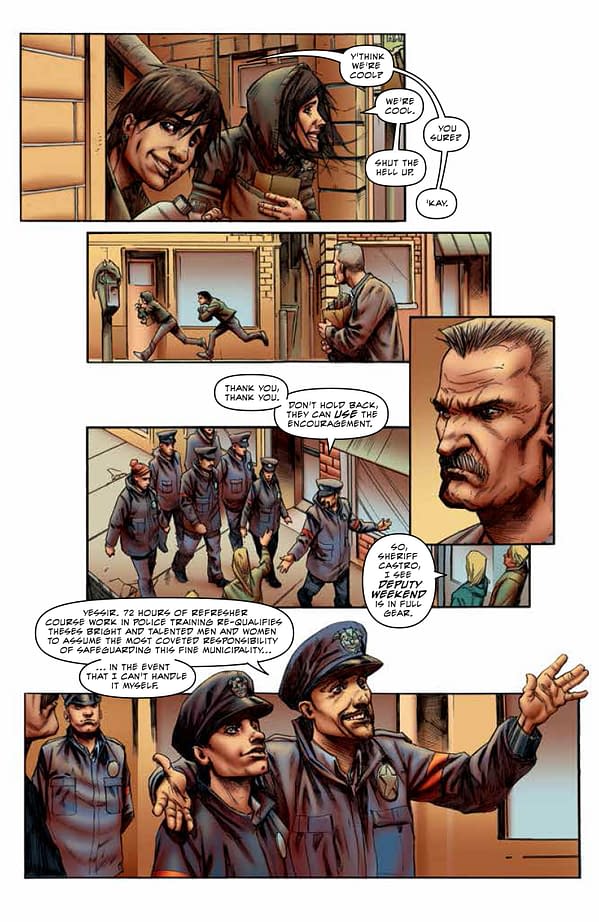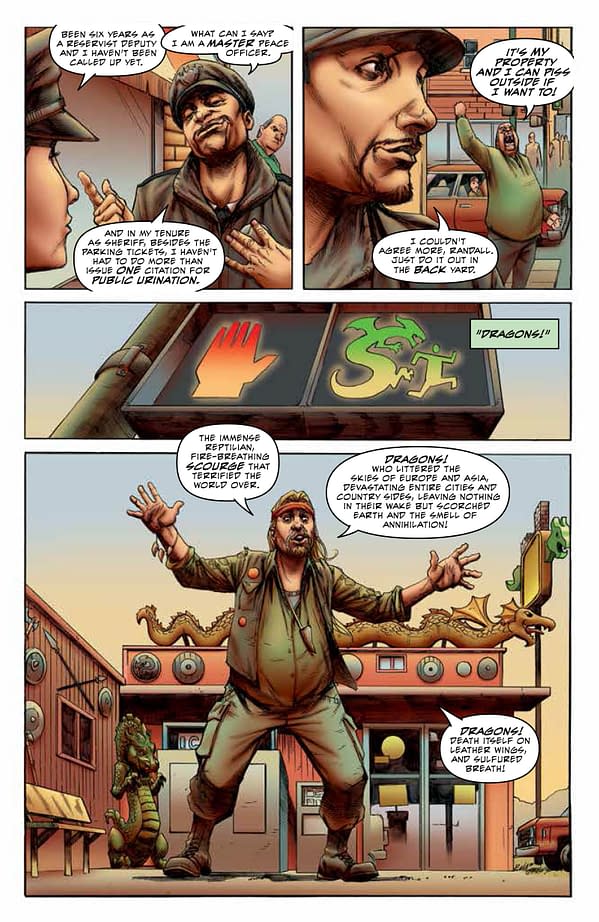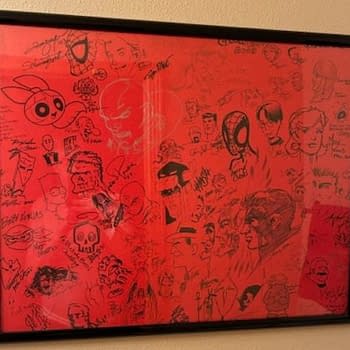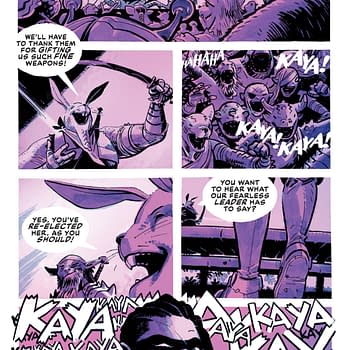Posted in: Comics, Recent Updates | Tagged: A Town Called Dragon, Bob Schreck, buzzkill, Comics, entertainment, Geoff Shaw, Jamie Grant, judd winick, legendary comics
'Something About Big, Spectacularly Large Monsters Just Makes Me All Warm And Fuzzy' – Geoff Shaw Talks A Town Called Dragon

Veteran writer Judd Winick has crafted a story that gave Shaw his own fearsome wings by bringing the advent of a "real" dragon to modern-day Colorado where the decision to fight or flee sifts through the population until we are left with a group of highly unlikely would-be heroes. Who don't seem to care that by remaining to fight they are facing "certain death". A Town Called Dragon from Legendary Comics is one of those books that might fly (no pun intended) under your radar but then leave you facepalming when the lists for notable books of 2014 start coming out. Don't let it blindside you then–get on board now.
That's just my humble advice after talking with Geoff Shaw and hearing his high-spirited enthusiasm for just about every aspect of creating this series bursting through:
Hannah Means-Shannon: Just for context, I once did an interview with you and Donny Cates about Buzzkill that was rather hilarious because we talked about bears the whole time.
Geoff Shaw: Oh yeah, I remember!

But anyway, looking around the internet at your other work, and now at A Town Called Dragon, I think it might be fair to say that you like drawing monsters. How do you see yourself as an artist in terms of what most interests you to work on?
GS: I love monsters. Next to bears, they are my favorite to draw. [Laughter] But the goal of any storyteller is to tell good stories. And to be challenged. For me, that's drawing things I've never drawn before and telling a story that's worth telling. I hope that story will stick and be remembered, but whether people love it or hate it, I want it to be special. My goal is also to have characters that stick out and are memorable. But when I hear that something's about a dragon, it would be hard to find an artist to turn that down. It's like dinosaurs—everyone secretly wants to draw them. I love superhero books, but normal, human drama is also very interesting to me. Bob Schreck saw some monster stuff in my portfolio and Bob is a big fan of monsters himself, so we connected on that. Something about big, spectacularly large monsters just makes me all warm and fuzzy. [Laughter]

GS: No, this is a scary dragon. I hope. That's what I was going for. So, if I scare a couple people, that would be a job well done. There are so many dragons out there. There have been so many stories about dragons, so many movies and so many comics. I researched around and I wanted to make my dragon stand out, which is a challenge with so many on the market. I couldn't find a comic book that focused primarily on a dragon, which may be my fault. They show up in comics here and there, sporadically, like in fantasy books that are out there. Some Marvel books have dragons. But they only ever come in as plot-points or in big, epic final scenes. They seldom carry the book. So I had to create a dragon who could carry the entire story and be cool to look at throughout the entire thing. I scoured the interwebs and I think I picked and chose a few elements I liked from all sorts of different dragons to create the one that I did finally come up with. It was definitely a challenge. It was a case of trial and error, and I think I succeeded. That's to be seen.
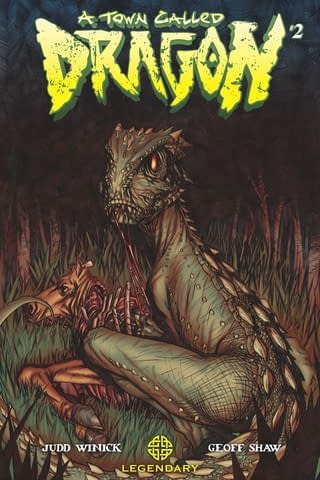
GS: Oh, yeah. It gets a little gory. It's not for the light consumer. It definitely pushes the gross factor a little bit. Which is also a blast to draw.
HMS: Well, I think it's going to be more shocking in some ways because this is set in America and because it's somewhat modern day. It's a neat contrast because we may get used to seeing dragons in a medieval or fantasy setting but then when you're presenting them in Colorado with tourists and normal people…
GS: It's definitely a jarring notion. Right off the bat, there were connections drawn between movies where you put a dragon in a real-life setting, but not in present day. I think if you take a dragon and put in a present-day, non-superhero world, that is what makes it so cool. We really tried to ground it, and Judd really tried to ground his story in normality, and so placing something so spectacular in it is a fantastic and fresh idea, in that respect.
HMS: I'd agree. I haven't personally read any comics where it was modern day like that.
That reminds me about something that I think Donny Cates said about you awhile back as an artist, which is that you're noticed for your "acting" and the way that you pick out your human characters and their movements and features, so presumably to pull this story off, you really have to get the reader involved with these characters and make them feel like real, modern people. How did you go about designing the different human characters?
GS: Judd had given me rough outlines of who these people were, but it was kind of up to me to flesh out the characters. That did challenge my skills. Aside from gigantic, spectacular monsters, I love drawing the acting part of comics. I think that taps into my deep desire to be an actor. I don't have the inclination to do that, but this flexes that muscle a little bit. Each character in the story has their own quirks and specific personalities. They really stand out from one another, so it was really fun coming up with the specific looks and tics for each character.
There is a group of people who end up banding together to face the dragon, and they all have their own hang ups, their own baggage, that they have to deal with in the face of this. Not only that, but it's a really diverse cast, which is really interesting for me. Not only ethnically, but each of the characters comes from a completely different walk of life. So there's the challenge. It's hard enough, if this were to happen in real life, to keep people from panicking, and running, and freaking out, but to get such a diverse cast to stand up against almost certain death is a really compelling concept. I think that really stands out in the story.

GS: Who isn't? I think the best stories focus on fuckups. If a character starts out on top, you're either going to watch them fall, or watch them grow. You want to watch them grow and become better people. People want to see stories about flawed characters growing, and rising to the challenge. And I want to imagine that if a dragon did come to my town, then yeah I'd get up and take it on, sure! [Laughter]
We want to believe that we could rise to the challenge, myself include. Though I think I'd probably be one of the runners. I'd want to live. We all want to believe that despite all our flaws, we could rise to that challenge and be the heroes that we all secretly wish that we were. I think all of these characters have elements of that. They all have their hang-ups, their flaws, their baggage, and they all have to overcome those dispositions to do the right thing.
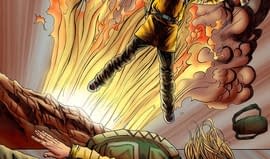
GS: Yeah. Well, actually, Buzzkill was my first foray into inking and pencilling myself. Originally, when I met Bob a few years ago, my ambition was to be a penciller only and my portfolio was tailored that way. It's a different sensibility. I love both. I love pencilling and I love inking and the organic quality of putting ink down on paper. But as soon as I get a pencil in my hand and am finishing a drawing with a pencil, it brings out a different part of my artist self. It makes me want to render more and get more detailed. It's my ambition to nurse both of those in different capacities. Because this is a monster story, it lends itself to wanting to see more details, and scales and such. I love them both, working with pencils and working with ink, but I think it just depends on the story.
HMS: It looks like the inking on this book is deferential toward the pencils, in a way much more than Buzzkill even does. Maybe you're harsh on yourself when you're inking yourself?
GS: Well, actually, this book is all pencils. There's no actual ink! So that's why! I'm not screwing up my own pencils this time. It's all me, and then the fantastic Jamie Grant is doing his best to cover up my flaws as best he can.
HMS: How does it work when there's no inking? Pardon my ignorance.
GS: Well, it's work by the penciller. And it's a penciller's dream, because you don't have to worry about anyone interpreting your line work, or me ruining my own linework. It's really freeing. You get all your line work, and texture, and grades preserved, but there's also room for the colorist who has to take all those greytones and they kind of do that like an inker, in a sense, without having to do all the darker lines. They get to pick out areas that should be darker and more bold and leave areas like the fine render lines. We have a nice balance between that, and I think Jamie and I worked really well together on that. He didn't step over the pencils and he did fantastic things with the colors popping them out and giving volume to the lines he put down.
HMS: Thank you for explaining that. I appreciate it.
GS: Well, it's not something you see all the time. I'd say it's something that's relatively new because of the advent of the digital age. You couldn't do that 20 years ago, but now with photoshop, a colorist can go in there and darken pencil lines to stand out on the page, whereas they used to have to use an inker for everything. It has its own quality to it. There's still something I think you get from inking that you can't get otherwise, but I think this is a really cool style in its own right that I think we pulled off. Or hopefully pulled off.
HMS: It really has a unique visual feel and depth. And you mentioned the colorist "popping" things. Having been to Colorado a few times myself, I noticed the way he captured the stark light in a way that's authentic to a regional setting.
GS: Oh, yeah. Jamie knows his stuff. He doesn't mess around. I was supremely lucky to have him on this.
HMS: You mentioned that Judd had given you a lot of freedom in interpreting things. What's the normal process like working together?
GS: This process was super stream-lined and easy working with him. I would get the script a couple months beforehand and come up with some character designs and shoot those over to him first. Then he'd approve the characters. Then I'd do the thumbnails from there, and he'd approve them. It was a very fluid process and we were all on the same page with the kind of story that we wanted to tell. I only heard positive things back and Judd's script was really fun to work on. I was on Cloud 9 pretty much every page.
HMS: So this is 5 issues. What else are you getting up to these days? Any other projects you are thinking about or working on?
GS: Well, I'm not sure what I'm allowed to say, but my next book will be with Dark Horse and Donny Cates. But it hasn't really been announced yet. That's probably going to take a lot of my time. I'll be looking into more creator-owned projects. That's fair to say.
[*EDITOR'S NOTE: Post-interview, Geoff Shaw's co-conspirator, Eliot Rahal blew the lid off a teaser that he, Donny Cates, Geoff Shaw, and Lauren Affe would be bringing a new comic to Dark Horse set in the same universe as Buzzkill in Summer of 2015. So there you have it.]
HMS: Ok thanks. Are you going to be at New York Comic Con?
GS: I'll be there. I'm not in Artists Alley, but I'll be signing some artwork and I will be walking the floor and talking comics.



